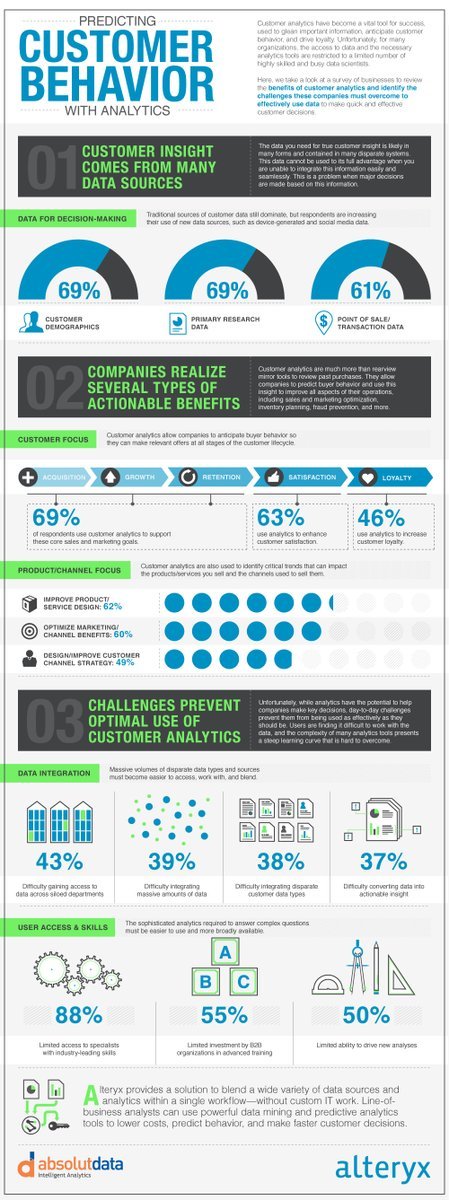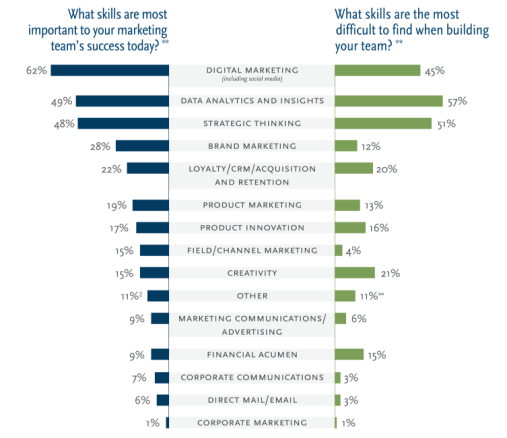Predictive analytics is probably the hottest thing in marketing analytics right now. Predictive analytics go beyond describing consumer behavior to predicting how consumers will behave in the future based on data.
If you’ve never heard of it, don’t feel bad–marketing lags behind many other business disciplines in using data to drive decision-making. In fact, marketing still struggles with descriptive statistics, which merely describe behaviors, such as visits, ad responses, etc.
Marketers shouldn’t feel bad about their reliance on squishy analytics, such as increased awareness. In the past, marketers just didn’t have access to data, which was locked in the minds and hearts of consumers. Gaining access to this data was very expensive and time-consuming, forcing marketing managers to use less accurate and nuanced data such as customer demographics and point of sale data, according to this infographic by Absolutdata and alteryx.
But, with digital marketing, marketing managers now have access to a plethora of valuable data and many struggle with how to use it although that access might be restricted to data analysts and they may lack the skills necessary to draw insights from the data.
So, today, I’d like to share some strategies for using predictive analytics, which, are exactly what they sound like. They predict behavior, rather than simply reporting on it.
What are predictive analytics?
We talk about 3 types of analytics:
Today, we’ll focus on predictive analytics, but if you’re interested in learning about the other 2 types of analytics and how they can help improve ROI, check out the links above.
Put simply, predictive analytics, as their name implies, try to predict the future, while descriptive analytics describe the past and prescriptive analytics help plan the best course of action (for instance, what are the best routes for buses in a major city).
Companies struggling to understand or implement descriptive analytics are now challenged to adopt this new form of analytics. A big part of the problem is data and the skills to analyze it are restricted to a limited number of data scientists who, often, lack the conceptual background to know what they’re looking for when it comes to predicting consumer behavior.
Benefits of predictive analytics
According to SPSS:
Organizations that incorporate predictive analytics into their daily operations in this way improve their business processes, enhancing decision making and gaining the ability to direct, optimize, and automate decisions, on demand, to meet defined business goals.
And, based on survey data, Forbes says:
A vast majority of executives who have been overseeing predictive marketing efforts for at least two years (86%) report increased return on investment (ROI) as a result of their predictive marketing.
Only 5% say they’ve not experienced an improvement in ROI or a decline in ROI from their efforts at predictive analytics.
Uses of predictive analytics in marketing
Arguably, predictive analytics support most enterprise activities, but I’m focused on marketing. Here are some uses for predictive analytics in marketing:
1. Segmentation
Segmentation involves separating a market into subgroups with similar attitudes, demographic, geographics, or behaviors. After segmenting your market, you position your product to appeal to the wants and needs of the chosen segment(s)–your target market.
Data aids in crafting your target segment(s) and determining the most effective positioning for each. Predictive analytics also helps to identify the most profitable segments based on historical consumer behavior within each segment.
Marketing managers use this data to allocate resources to reach the most profitable segments.
2. Forecasting
According to HBR, the biggest use of predictive analytics is in developing demand models that forecast sales and revenue–the starting point for budgeting.
3. Demand pricing
Demand pricing, often called yield management, involves pricing products based on differences in elasticity of demand between consumer groups. For instance, business travelers are willing to pay more for a seat on an airplane than casual travelers, so you can charge them more and reduce the price to casual travelers to make your flights more competitive and still meet ROI goals.
Using predictive analytics, firms conduct a series of experiments to determine factors affecting the impact of price on demand. Using these predictive models, firms develop optimum pricing strategies that maximize ROI.
4. Improve customer satisfaction
Customer satisfaction greatly impacts retention and loyalty. It also improves other positive consumer behaviors, such as recommending the brand to others. Any improvement in customer satisfaction impacts ROI, potentially significant. That’s the entire basis for the rise of relationship marketing, where marketing shifts its focus to pleasing existing customers than attracting new ones. Data suggest that it’s 5X less expensive to keep an existing customer than replace that customer.
Using data from customer service calls, mentions on social media, etc offer insights into factors leading to poor customer satisfaction. Using predictive tools such as conjoint analysis allow firms to discover which product improvements generate the greatest improvement in customer satisfaction.
Challenges to implementing predictive analytics
Looking at the infographic, we see that 43% of those surveyed feel that gaining access to the data is the biggest problem affecting their ability to use the data. Much of the data is housed in numerous functional silos, units of the organization, or across country borders making it difficult to get a clear picture of how customers respond to marketing efforts. Another 39% of respondents report difficulties integrating data across various places where it is stored. Creating actionable insights from the data is reported with only 37% of respondents. My guess is that this number.
Creating actionable insights from the data is reported with only 37% of respondents. My guess is that this number is even larger, in reality, and a function of the old adage “you don’t know what you don’t know”. Using data mining techniques mindlessly doesn’t generate insights and may obfuscate true relationships hiding in the data. Instead, knowledge of consumer behavior should guide analysis by identifying variables likely to impact important behaviors.
And, this is the real difficulty. Marketers aren’t often trained in data analysis techniques and the colleges and universities firms count on to teach these skills shrink from the job because they fear losing students or getting poor evaluations from students who hate analytics and math. To mitigate this problem, firms sometimes hire engineers who possess sufficient analytical skills, not realizing the true impact of their lack of knowledge about marketing concepts.
Solutions
An obvious solution is to improve the analytical skills of marketers either by paying to train marketers or by hiring marketers with analytics training (which is easier said than done according to the infographic above showing 57% of firms have trouble hiring employees with analytical skills).
Alternatively, firms can buy software solutions that don’t require high-level analytical skills, such as those produced by the authors of the infographic.
That still leaves the issue of data spread all over the organization. Solving this problem requires firms develop comprehensive data collection and storage plans that ease integration across different units. Combining data from different databases requires a key to link the data together as well as skills such as SQL to manage the integration. Again, software exists that allows firms to integrate with little technical knowledge.

